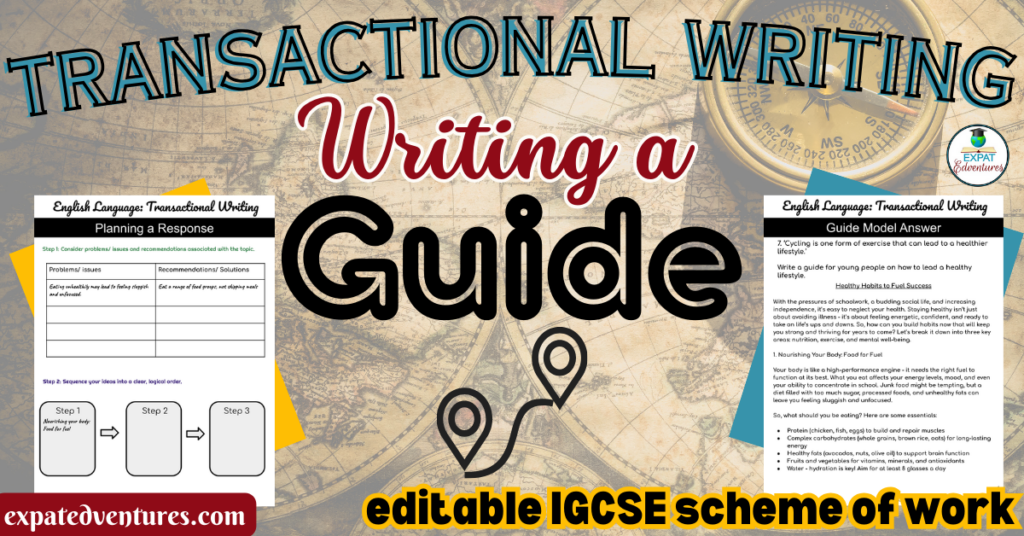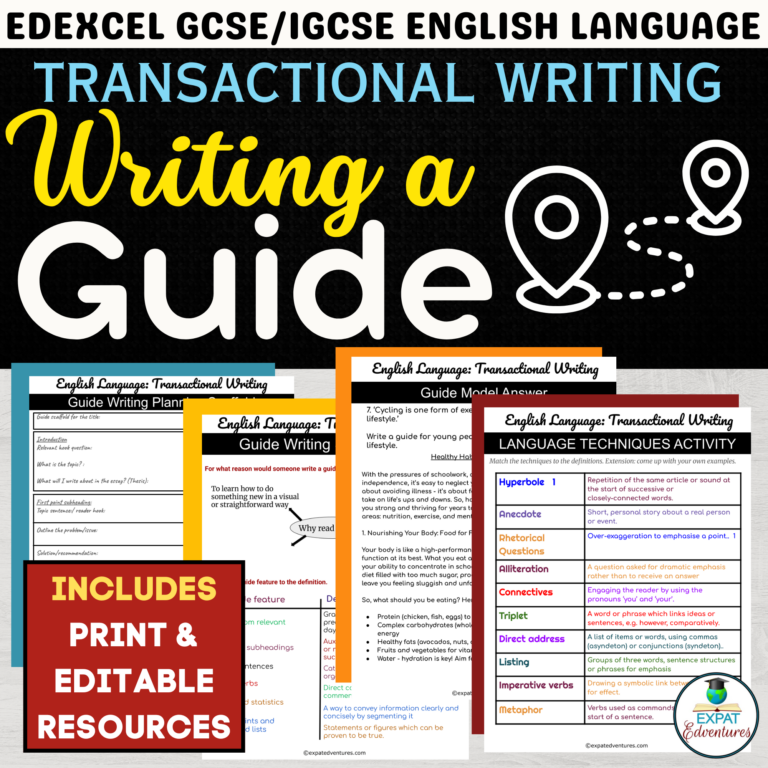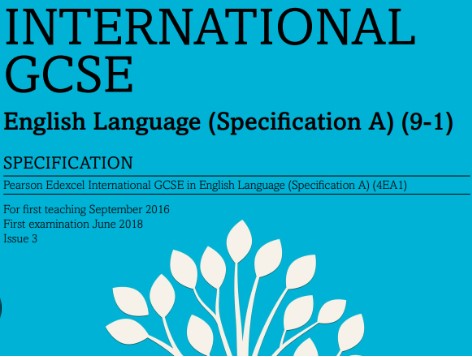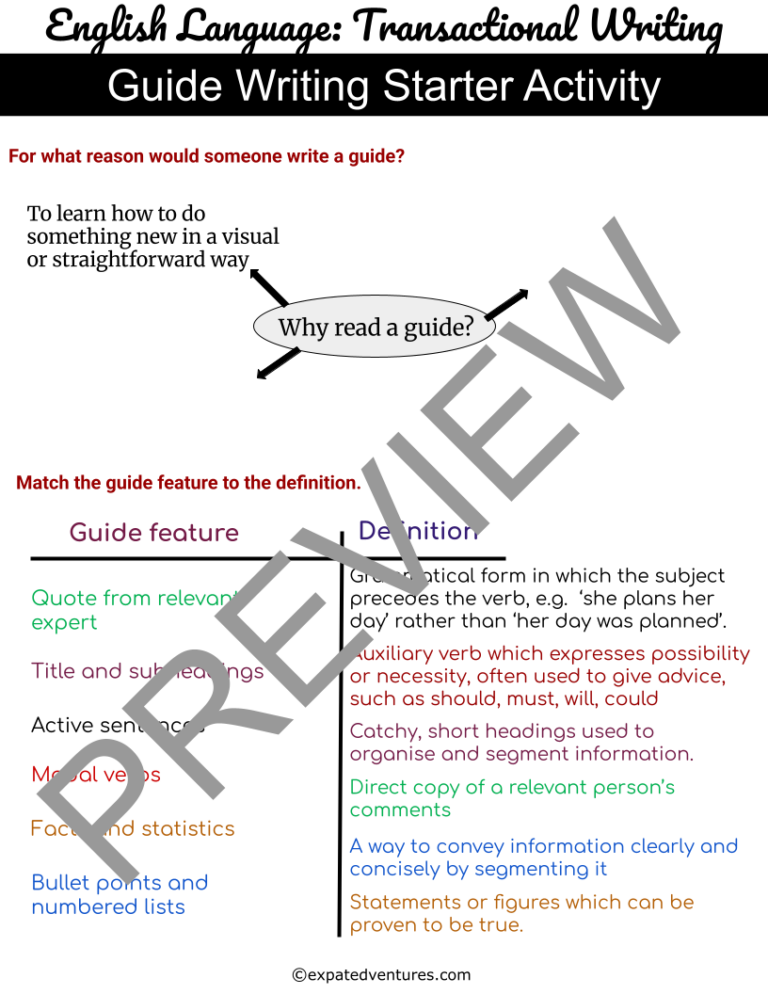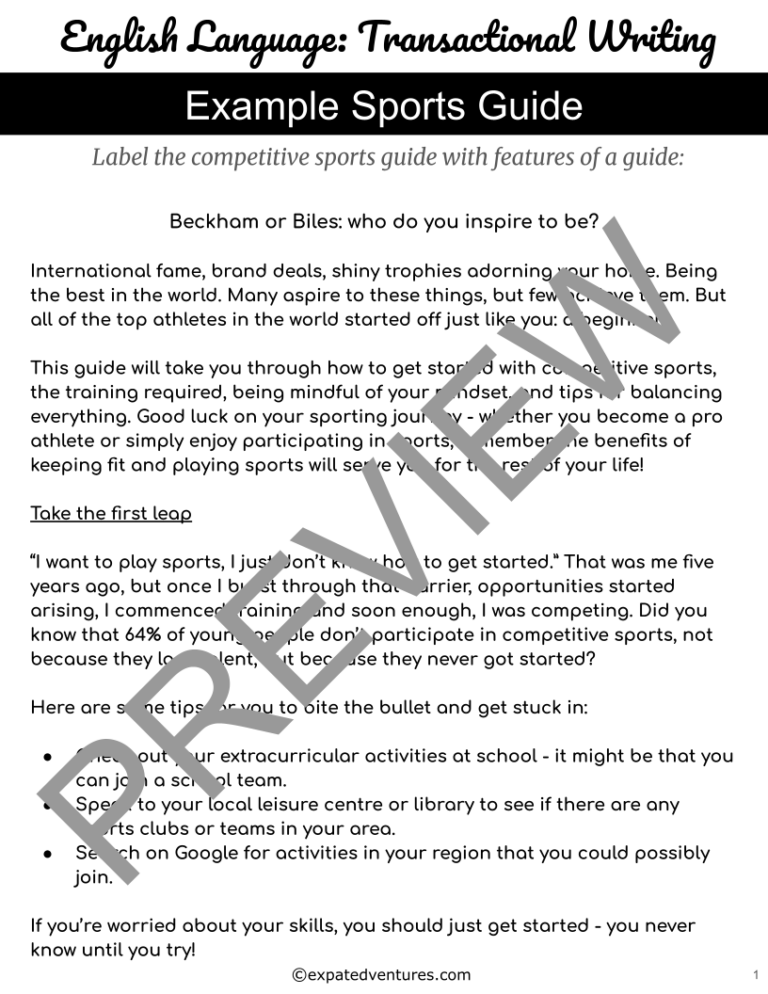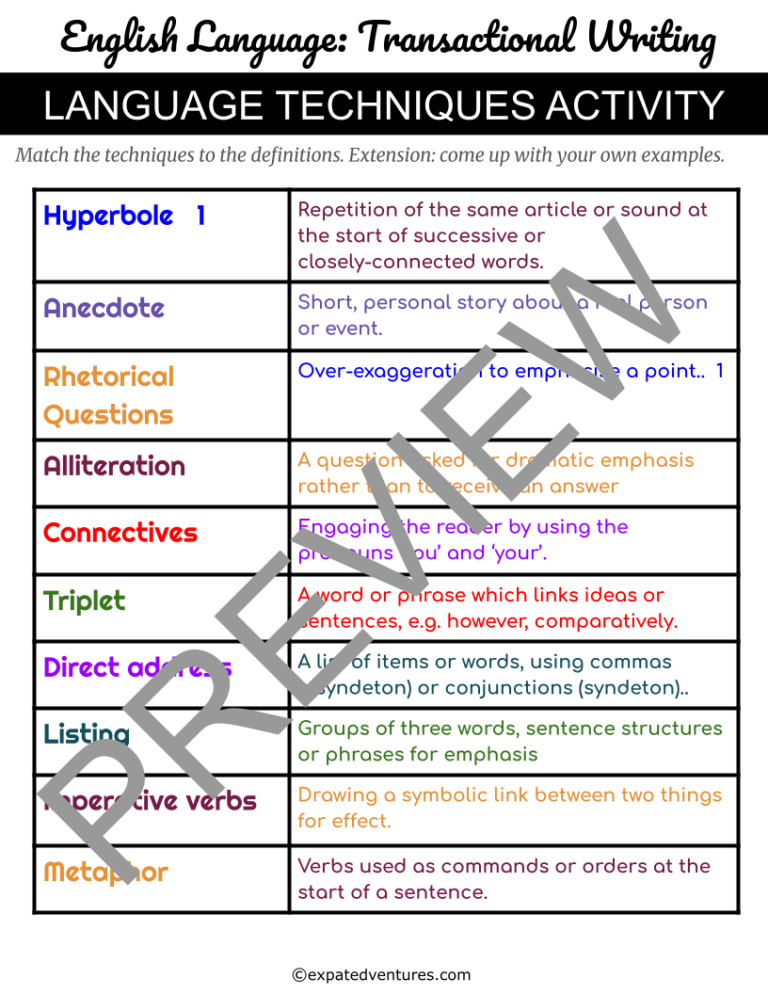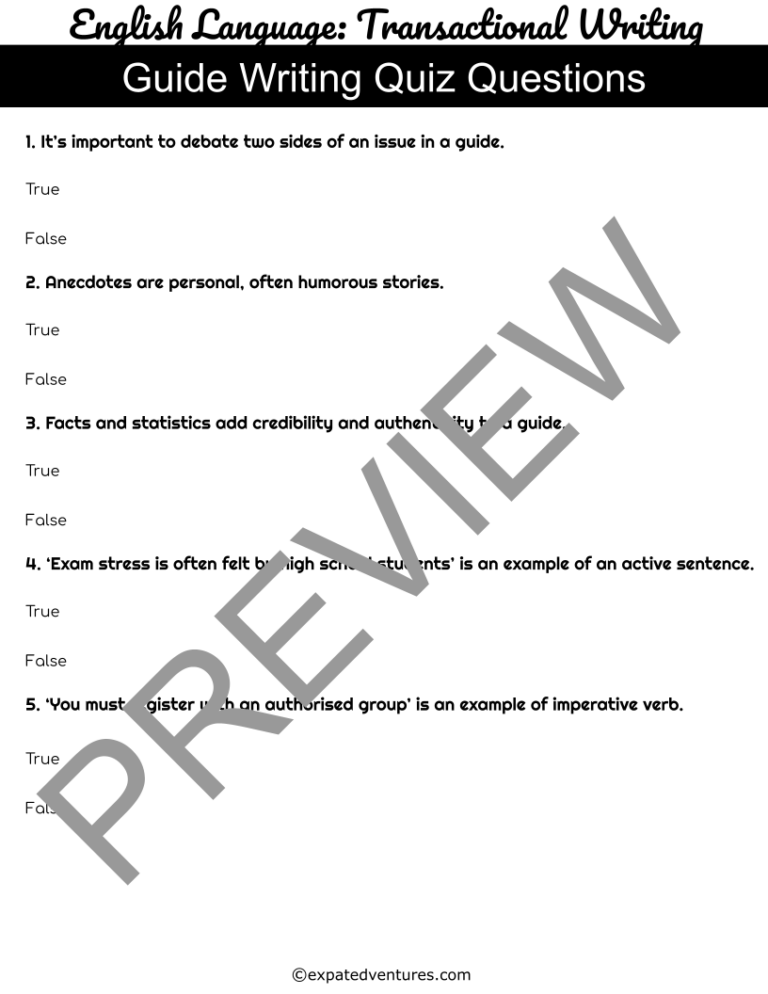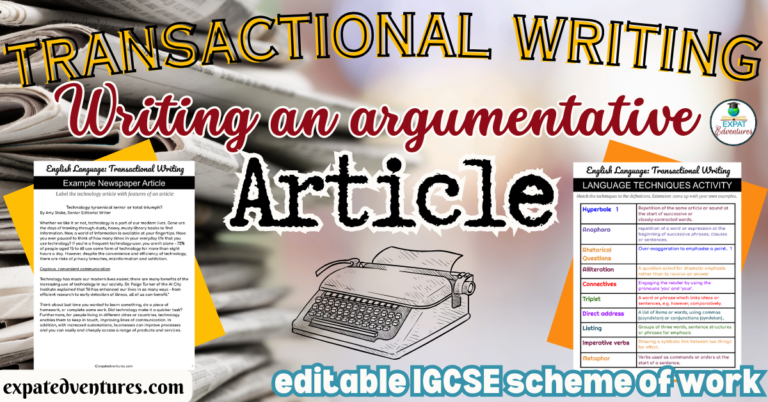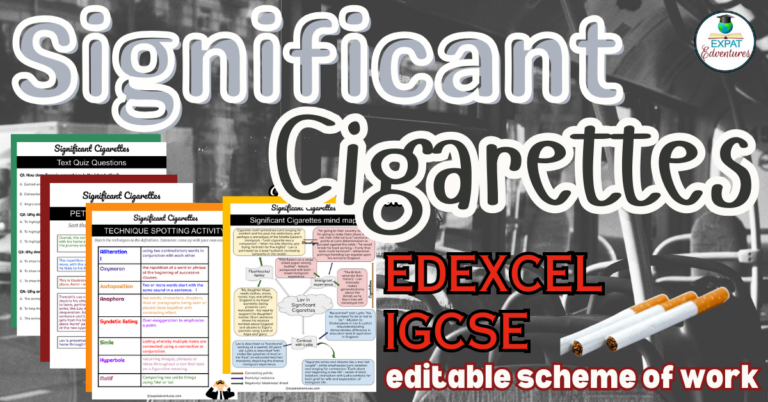GCSE guide writing is currently taught on the Edexcel GCSE/IGCSE English Language Paper 1 curriculum. That is, it’s one of the text-types which comes up on Section B of the English Language Paper 1. Although some students think that writing a guide is straightforward, writing in a logical, clear, and cohesive way is not so easy. Plus, I tell students that learning to write a sequenced guide can help with structuring reports and written documents, something people do in many roles and professions.
The Pearson Edexcel English Language exam could ask a range of questions which require GCSE guide writing skills. Therefore, it’s imperative that students have a variety of language and structure conventions in their exam toolkits. This editable GCSE guide writing unit ensures students are prepared for all English Language Section B guide writing questions.
GCSE Guide Writing Scheme of Work
I’ve created a scheme of work for busy teachers to take you step-by-step through teaching guide-writing. It contains everything from an engaging, thought-provoking starter to identifying language and structure techniques. Additionally, it comprises activities from analysing and annotating an example guide to practising an Edexcel GCSE past paper question on the text.
This GCSE guide writing resource contains editable Google slides, a model guide, a scaffold and mark scheme and an interactive guide writing quiz with an answer key. All activities are ready to download and print in PDF form or there are links for you to personalise them if you wish.
Edexcel IGCSE English Language Exam Paper 1
The 2 hour 15 minutes Edexcel IGCSE English Language Paper 1 exam is split into Section A and Section B. Section A is the reading assessment and candidates are presented with one of the 10 non-fiction Anthology texts and one thematically linked unseen text. The texts are between 1.5 and 2.5 pages long. They have 5 questions to answer in Section A:
- A 2 -mark retrieval question. Lifting and copying two brief and relevant quotes from the unseen text is the skill being assessed in this question.
- A 4-mark summary question. Candidates are asked to paraphrase a certain event, character or theme from the unseen text.
- A 5-mark ‘SQUID’ question (it’s an acronym not a slimy sea creature!). Students identify five distinct details from the unseen text and use quotations to support their points.
- A 12-mark extended analytical response on the seen text.
- A 22-mark comparative essay, usually based on the writers’ perspectives, experiences or feelings.
Section B is a writing assessment. Candidates choose between two options, which are normally loosely based on the Section A texts. The text types include a letter, article, speech or leaflet. Both Section A and Section B are equally weighted, worth 45 marks each. Students are assessed on their ability to adapt their tone, style and content to the question and intended reader. Additionally, grammar, spelling and punctuation are on the Section B writing rubric.
GCSE Guide Writing Tasks
To start off, I encourage students to consider the reasons for writing or reading a guide. This generates ideas about purpose. I ask students to brainstorm ideas for a few minutes, giving them an example to start them off. They can do this in pairs or individually.
After taking feedback, I ask students to match definitions to guide features. This gives them specific techniques they can apply to their writing which demonstrates an understanding of the distinctions between the guide text-types and others that may come up on the exam.
Features of a GCSE Guide
When the exam question calls for a guide, I like students to be prepared to use structural conventions of a guide. They receive credit for varying their style and structure depending on the question. Using the format of a guide helps to explicitly show the examiner that they recognise and are responding to the specific question, rather than providing a generic answer.
I find the best way to do this is share an example guide and ask students to highlight and annotate the features. The full example guide is available as an editable PDF in this GCSE guide writing unit. Also, there are annotations and notes available in the Google slides.
Once students have annotated the features, such as subheadings, bullet pointed lists, and quotes from experts, I share the answers with them in the slides. Most students are easily able to identify the features of guide writing, but the tricky part comes in structuring a cohesive, engaging sequence of ideas whilst incorporating relevant language techniques.
Persuasive Language Techniques
After identifying the structural conventions of GCSE guide writing, the next step is for students to effectively construct their guides. A key to engaging the reader in the guide is using persuasive techniques. To that end, there is a techniques and definitions matching activity included in this GCSE guide writing resource. As an extension, students could write their own examples of the techniques. Depending on the level of your class, you could do this as a quick review activity on the interactive whiteboard. Or, you could have students complete on paper or in their exercise books.
To see how these techniques are used, its best to see them in an example. So, I ask students to return to the example guide we annotated for features of guide writing. I then ask students to identify as many of the persuasive techniques as they can. I have included detailed annotations of language techniques in the example guide with the GCSE guide writing scheme of work.
GCSE Guide Writing Quiz with Answer Key
Depending on the prior knowledge of your class, they may now have learned or reviewed quite a lot of information. Before asking them to apply that knowledge, I like to do a formative assessment. I have included a low stakes true or false quiz on the language and structure features of guide writing with the resource. You can do this either as a class on the whiteboard or print for students to complete on paper.
GCSE English Past Paper Questions
Now that you have covered the skills involved with writing a guide, it’s time to introduce a task. I have included a guide writing question based on past paper questions. Sometimes questions are like the one included in this scheme of work, whereby students are asked to write an informative guide on a certain topic. Other years, the exam asks for students to compose a personal recount or review of something, more of an opinion piece.
For transactional writing, there are 45 marks available on the mark scheme. They are split between A04 (content, style and quality of communication) and A05 (spelling, grammar, punctuation and sentence structure). After sharing the question with students, I go through the rubric with them. I have included a more student-friendly rubric in the guide writing scheme of work.
If it’s the first-time students have attempted a GCSE question like this, they may need support in the form of scaffolding. The guide writing resource contains a planning scaffold along with notes, questions and ideas to help students formulate cohesive ideas.
Transactional Writing Example
Next, students will attempt to answer the question. Following this, I like to share a full mark model example so that students can identify their strengths and areas to improve. I find that students will often ask me, “if my mark is X, how do I improve it?” It benefits them to see exactly how to do that by analysing a full mark example answer.
GCSE Writing Checklist
You will find a useful checklist for students to use whilst writing their responses in the guide writing scheme of work. It’s a helpful tool to guide their revision also.
To sum up, some of the best techniques for teaching students how to write a guide include:
- Hooking students with an intriguing starter activity.
- Demonstrating features of a guide and persuasive language techniques in an example guide.
- Quizzing students for a quick AFL strategy to assess whether they are understanding the material.
- Practising a past paper GCSE question, using scaffolds and models to help students formulate cohesive and relevant ideas.
- Comparing their responses to a model to constantly strive for improvement.
Good luck teaching GCSE guide writing – it’s always interesting to hear students’ opinions on the topics raised in the transactional writing questions. I love to read their perspectives and ideas. Comment below if you can add any useful teaching and learning techniques for this text.
If you enjoyed this guide about teaching GCSE guide writing, you might also find value in my Edexcel IGCSE Paper 2 guides and resources for ‘Out, out-‘ and ‘Disabled’. There are also Edexcel IGCSE English Language Paper 1 guides and schemes of work for many of the set texts, including The Danger of a Single Story and Explorers or boys messing about.
Moreover, you might want to use the complete GCSE letter writing unit and the helpful GCSE speech writing resources. Thank you for reading and follow my store for more as resources are constantly being added.

